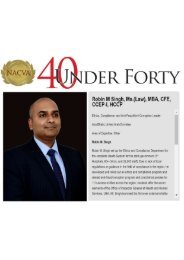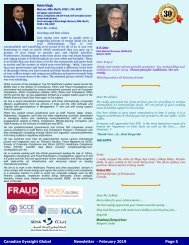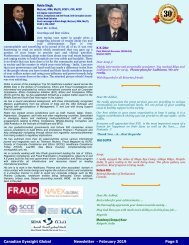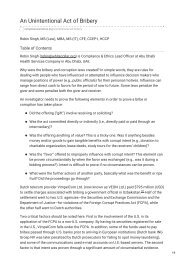Anti-bribery programs: A web of ethical and legal dilemmas
The role of the #iso37001 in curbing the #corruption and safeguarding organizations from #legal exposure with #robinsingh and #SCCE (Society of Corporate Compliance and Ethics)See Less by #RobinSingh the #whitecollarinvestigator
The role of the #iso37001 in curbing the #corruption and safeguarding organizations from #legal exposure with #robinsingh and #SCCE (Society of Corporate Compliance and Ethics)See Less by #RobinSingh the #whitecollarinvestigator
Create successful ePaper yourself
Turn your PDF publications into a flip-book with our unique Google optimized e-Paper software.
Compliance & Ethics Pr<strong>of</strong>essional ® June 2017<br />
questions in a matrix could surround the<br />
following subjects:<br />
· Is the program consistent with all laws<br />
relevant to countering <strong>bribery</strong> in each <strong>of</strong><br />
the jurisdictions in which you operate?<br />
· Is the program evolving? (i.e., do the<br />
investigation/compliance reviews tie<br />
back to the regulatory risk register <strong>and</strong><br />
subsequently to the program?)<br />
· How is the program managed, <strong>and</strong> how<br />
does it tie up with the jurisdictional<br />
exceptions where the business<br />
entities operate?<br />
Not only will the questions provide<br />
a useful overview <strong>of</strong> compliance status,<br />
but they can also help an organization to<br />
correlate risk assessments, prioritize risk, <strong>and</strong><br />
provide valuable management information<br />
for both process improvement <strong>and</strong> quality<br />
improvement.<br />
Defining the maturity <strong>of</strong> an anti-<strong>bribery</strong><br />
compliance program<br />
This is a very touchy subject because<br />
the set-up period in the life cycle <strong>of</strong> a<br />
compliance program requires patience <strong>and</strong><br />
perseverance. Management will not see a<br />
measurable output for the amount <strong>of</strong> input<br />
that requires so many resources, employees,<br />
<strong>and</strong> budget. Compliance <strong>programs</strong> do not<br />
mature overnight, but rather take time to<br />
develop <strong>and</strong> become entrenched. A program<br />
in its implementation phase will likely<br />
be relatively inflexible <strong>and</strong> will only see<br />
minimum levels <strong>of</strong> compliance, as it likely<br />
doesn’t have anticipator capacity at this point.<br />
As the program matures, it will become<br />
more flexible, proving itself able to learn<br />
from, provide management with a tangible<br />
output, <strong>and</strong> adapt to different regulatory<br />
scenarios. Staff <strong>and</strong> personnel in the program<br />
will also become more knowledgeable, <strong>and</strong><br />
the program will generally become more<br />
integrated with other units. As the program<br />
matures, gains in efficacy <strong>and</strong> efficiency can<br />
be expected.<br />
The maturity should never be looked at<br />
in isolation, but rather in the context <strong>of</strong> the<br />
business <strong>and</strong> its growth. After all, a Compliance<br />
department is a cost center <strong>and</strong> needs to justify<br />
its existence. Some <strong>of</strong> the elements in a mature<br />
compliance program could incorporate:<br />
· Technical <strong>and</strong> business tools are used to<br />
enhance an organization’s competitive<br />
advantage;<br />
· Budgeted resources are maximized, because<br />
tasks are better planned <strong>and</strong> coordinated;<br />
· The program has maximum flexibility <strong>and</strong><br />
is “anticipatory” in the sense that it can<br />
anticipate <strong>and</strong> respond to needs;<br />
· Staff <strong>and</strong> personnel can assist government<br />
regulators in setting st<strong>and</strong>ards <strong>and</strong> policies;<br />
<strong>and</strong><br />
· Business relationship with third parties<br />
are enhanced.<br />
Implementing the value <strong>of</strong> compliance<br />
A compliance program or an anti-<strong>bribery</strong><br />
program can be a valuable resource for<br />
companies seeking to develop <strong>and</strong> implement<br />
an anti-<strong>bribery</strong> st<strong>and</strong>ard <strong>and</strong> curb any criminal/<br />
un<strong>ethical</strong> conduct that might exist. Frameworks,<br />
including the ISO 37001, can help organizations<br />
that operate outside the jurisdictions <strong>of</strong> the<br />
U.S., UK, or Europe to respond to allegations<br />
<strong>of</strong> <strong>bribery</strong> <strong>and</strong> corruption. By implementing<br />
a compliance program that adheres to ISO<br />
37001 in the jurisdiction, a company can<br />
empower local staff to stop perpetuating acts<br />
that can lead to dem<strong>and</strong>s for bribes <strong>and</strong> protect<br />
their organizations in the ever-changing<br />
regulatory environment.<br />
ISO 37001 is being developed as a<br />
requirements st<strong>and</strong>ard, meaning that it will,<br />
at some point, be capable <strong>of</strong> independent<br />
verification. It will therefore be possible for a<br />
third party to verify whether or not a company<br />
64 www.corporatecompliance.org +1 952 933 4977 or 888 277 4977
















